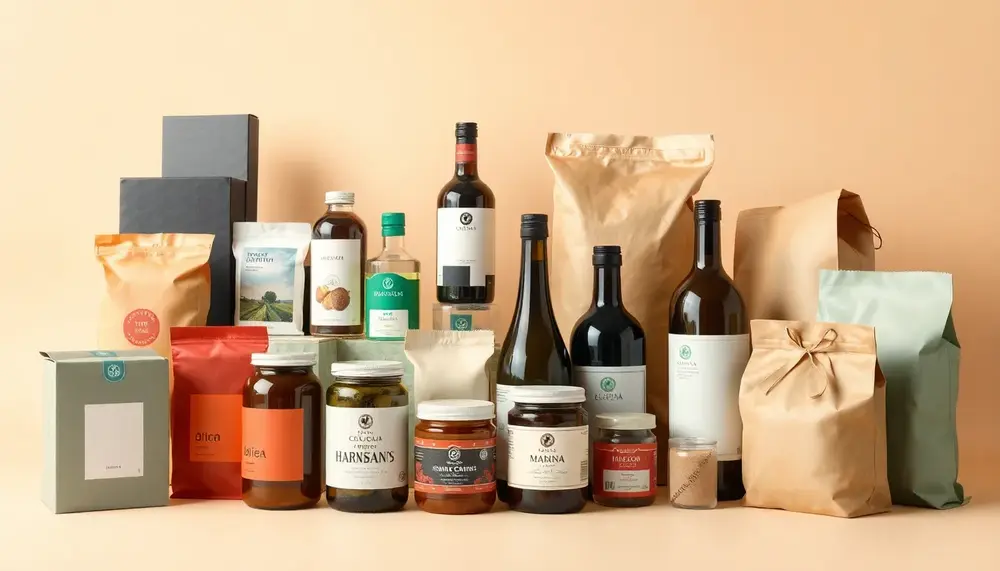Table of Contents:
Key Functions of Packaging and Labelling in Marketing Strategies
Key Functions of Packaging and Labelling in Marketing Strategies
Packaging and labelling are not just about wrapping products and sticking on a logo—let’s get that out of the way. Their true power lies in how they directly shape the consumer’s perception, guide buying behaviour, and reinforce brand promises. So, what are the actual levers that packaging and labelling pull in a modern marketing strategy?
- First Impression and Shelf Impact: In crowded retail environments, packaging is the silent salesperson. It’s often the very first touchpoint between your brand and a potential customer. A distinctive package can make a product leap off the shelf, triggering curiosity or even instant desire. In fact, research shows that over 70% of purchase decisions are made at the point of sale1.
- Brand Storytelling and Emotional Connection: Packaging and labelling communicate brand values, origin stories, and product benefits without a single spoken word. Through colour, texture, typography, and imagery, brands can evoke emotions, spark nostalgia, or signal innovation. This is especially critical for premium or artisanal products, where storytelling is half the value proposition.
- Trust and Transparency: Detailed, honest labelling builds credibility. Today’s consumers want to know what’s inside, where it comes from, and how it’s made. Clear ingredient lists, certifications, and even QR codes for deeper digital information can turn sceptics into loyalists. Transparency isn’t just a buzzword—it’s a conversion tool.
- Legal Compliance and Risk Mitigation: Accurate labelling ensures products meet regulatory requirements, avoiding costly recalls or legal disputes. It’s not glamorous, but it’s non-negotiable. Brands that treat compliance as a core function of packaging avoid headaches and build long-term reputational safety nets.
- Facilitating User Experience: Smart packaging design makes products easier to use, store, and transport. Think resealable bags, portion control, or tactile cues for accessibility. These features are not just “nice-to-haves”—they’re competitive advantages that keep customers coming back.
In sum, the key functions of packaging and labelling are deeply intertwined with every stage of the marketing funnel—from grabbing attention to sealing the deal and nurturing loyalty. Brands that treat these elements as strategic assets, rather than afterthoughts, consistently outperform their peers in crowded markets.
1: Source: Point of Purchase Advertising International (POPAI), 2014
Differentiation Through Packaging: Practical Approaches for Brand Identity
Differentiation Through Packaging: Practical Approaches for Brand Identity
Let’s face it: in a market flooded with lookalikes, standing out is not just a creative exercise—it’s a survival tactic. Packaging, when wielded smartly, is your brand’s fingerprint. But how do you carve out a unique identity with packaging, without drifting into gimmick territory? Here’s what actually works:
- Material Innovation: Choosing unexpected or tactile materials—think textured cartons, metallic finishes, or biodegradable films—signals premium value or eco-consciousness. This tactile experience lingers in memory, subtly nudging brand recall every time the product is handled.
- Signature Shapes and Structures: Unconventional packaging shapes, custom closures, or stackable designs can make a product instantly recognisable from across the aisle. Iconic examples? The contoured Coca-Cola bottle or Toblerone’s triangular prism—shapes that are inseparable from their brands.
- Colour and Visual Codes: Developing a consistent palette or pattern, distinct from competitors, reinforces identity. Brands like Tiffany & Co. own their signature blue, while others use bold contrasts or minimalist schemes to stand apart.
- Limited Editions and Seasonal Designs: Rotating packaging themes for holidays, local events, or collaborations injects freshness and urgency. These limited runs create buzz and encourage collection, all while reinforcing the brand’s cultural relevance.
- Localisation and Cultural Cues: Adapting packaging elements—such as language, imagery, or motifs—to regional tastes can foster deeper connections. Brands that tailor their packaging for specific markets often see a measurable lift in engagement and loyalty.
Ultimately, differentiation through packaging isn’t about being loud for the sake of it. It’s about crafting a visual and tactile language that customers instantly associate with your brand’s promise. When done right, packaging becomes more than a container—it’s a silent ambassador, working overtime on every shelf and in every hand.
Pros and Cons of Packaging and Labelling in Marketing Strategies
| Pros | Cons |
|---|---|
|
|
Effective Labelling: Driving Purchase Decisions and Building Consumer Trust
Effective Labelling: Driving Purchase Decisions and Building Consumer Trust
Labelling, when executed with precision and intent, does more than just inform—it persuades and reassures. The subtleties of effective labelling can be the tipping point between a product left on the shelf and one confidently placed in a shopping cart. Here’s how strategic labelling directly shapes consumer action and loyalty:
- Clarity and Simplicity: Labels that communicate essential details—such as product origin, usage instructions, and key benefits—without overwhelming the reader, streamline decision-making. Consumers appreciate brevity and transparency, especially when faced with too many choices.
- Highlighting Unique Selling Points: Well-crafted labels spotlight what sets a product apart, whether it’s “gluten-free,” “locally sourced,” or “award-winning.” These quick cues allow shoppers to align purchases with their values or needs, often within seconds.
- Certifications and Seals: Official marks like organic, cruelty-free, or fair trade instantly boost credibility. Shoppers trust third-party endorsements, and such labels can transform scepticism into confidence, especially in categories like food, cosmetics, and baby products.
- Traceability and Batch Information: Including batch numbers, production dates, or QR codes for supply chain transparency gives consumers peace of mind. This is particularly crucial for products where safety, authenticity, or freshness are non-negotiable.
- Accessible Design: Thoughtful font choices, high-contrast colours, and clear icons ensure that information is legible for all, including those with visual impairments. Accessibility isn’t just ethical—it broadens your customer base and signals genuine care.
In essence, effective labelling is a silent but powerful advocate for your brand. It builds trust not by shouting, but by delivering reliable, relevant, and easy-to-digest information right when the consumer needs it most. That’s how labels quietly drive both sales and loyalty, day in and day out.
Sustainable Packaging Solutions: Meeting Modern Consumer Expectations
Sustainable Packaging Solutions: Meeting Modern Consumer Expectations
Modern consumers aren’t just looking for products—they’re scanning for brands that echo their environmental values. Sustainable packaging has moved from a “nice-to-have” to a dealbreaker, with shoppers actively seeking out companies that minimise waste and carbon footprints. So, what does truly sustainable packaging look like in practice?
- Material Reduction and Lightweighting: Brands are trimming excess, designing packages that use less material without compromising protection. This not only reduces resource consumption but also slashes transportation emissions due to lighter loads.
- Monomaterial Solutions: Switching to single-material packaging—like all-paper or all-plastic—makes recycling far more efficient. Consumers are more likely to recycle when the process is straightforward, and brands benefit from improved circularity metrics.
- Refill and Reuse Systems: Forward-thinking companies now offer refillable containers or incentivise returns for reuse. This approach not only cuts down on single-use waste but also fosters repeat purchases and long-term brand loyalty.
- Compostable and Biodegradable Options: Packaging made from plant-based materials or biopolymers breaks down naturally, reducing landfill burden. However, brands must clearly communicate disposal instructions to ensure proper end-of-life handling.
- Supply Chain Transparency: Sharing the story behind packaging choices—such as sourcing recycled content or partnering with ethical suppliers—resonates with eco-conscious buyers. This transparency can be a powerful differentiator in saturated markets.
Ultimately, sustainable packaging isn’t just about ticking regulatory boxes. It’s about aligning every design and sourcing decision with the values of a generation that expects brands to lead by example. Those who get it right don’t just meet expectations—they shape them.
Integrating Smart Packaging and Digital Labelling for Customer Engagement
Integrating Smart Packaging and Digital Labelling for Customer Engagement
Brands pushing the envelope are now leveraging smart packaging and digital labelling to create interactive, data-driven experiences that go far beyond the physical product. This isn’t just about adding tech for tech’s sake—done right, it transforms how customers connect, learn, and even share.
- Interactive QR Codes and NFC Tags: By embedding scannable elements, brands can instantly connect shoppers to exclusive content, loyalty programs, or product authentication tools. This real-time access to information or rewards turns every package into a digital touchpoint, fostering ongoing engagement long after purchase.
- Personalised Digital Experiences: Dynamic labelling allows brands to tailor content based on location, season, or even individual preferences. Imagine a beverage bottle that shares a local recipe or a cosmetic label that updates with skin care tips relevant to the weather—suddenly, packaging becomes a living, evolving part of the brand story.
- Track-and-Trace Transparency: Smart packaging enables end-to-end visibility, letting consumers verify origin, monitor shipping, or check authenticity with a simple scan. This not only reassures buyers but also deters counterfeiting and grey market activity.
- Real-Time Feedback Loops: Some brands now invite instant reviews or feedback via digital labels, creating a direct line to customer sentiment. This rapid insight helps companies adapt quickly and makes customers feel genuinely heard.
- Gamification and Social Sharing: Integrating games, challenges, or social media prompts into packaging encourages users to interact, share, and advocate for the brand online. These playful elements can turn an ordinary unboxing into a viral moment.
In short, smart packaging and digital labelling aren’t just future trends—they’re fast becoming must-haves for brands that want to deepen relationships and stay top-of-mind in a hyper-connected world.
Real-World Examples: Successful Packaging and Labelling Strategies in Action
Real-World Examples: Successful Packaging and Labelling Strategies in Action
Examining real brands reveals how innovative packaging and labelling can drive results. Here are three compelling cases where companies have moved the needle by thinking outside the box—sometimes literally:
-
Absolut Vodka’s Limited Edition Bottles
Absolut’s “One Source” campaign introduced bottles with unique, numbered designs—no two were exactly alike. This strategy transformed each bottle into a collectible, sparking social media buzz and encouraging repeat purchases. The campaign’s success hinged on exclusivity and visual intrigue, which directly boosted shelf visibility and consumer engagement. -
Patagonia’s Recycled Content Labelling
Outdoor brand Patagonia has gone beyond standard eco-labels by providing detailed breakdowns of recycled content on its packaging. By quantifying the percentage of recycled materials and sharing the environmental impact, Patagonia built trust with its core audience. This level of transparency not only differentiated the brand but also empowered customers to make informed, values-driven choices. -
Oatly’s Conversational Cartons
Oatly, the oat milk disruptor, uses packaging as a canvas for witty, conversational copy. Their cartons feature playful language, product facts, and even brand philosophy, making the packaging itself a shareable talking point. This approach has cultivated a cult following and positioned Oatly as a bold, authentic voice in a crowded category.
These examples show that strategic packaging and labelling can create lasting brand impressions, foster loyalty, and even spark cultural conversations—outcomes that go far beyond the product itself.
Strategic Recommendations: Maximising the Marketing Impact of Packaging and Labelling
Strategic Recommendations: Maximising the Marketing Impact of Packaging and Labelling
-
Conduct Consumer-Centric Testing
Before finalising packaging or labelling, run iterative tests with real customers in relevant retail environments. Gather feedback on usability, emotional response, and shelf standout. Adjust designs based on observed behaviour, not just assumptions or internal preferences. -
Leverage Data Analytics for Optimisation
Track and analyse sales performance by packaging variant, region, and channel. Use this data to identify patterns—such as which colours, formats, or claims drive conversion—and refine your strategy dynamically. A/B testing packaging elements can yield actionable insights for continuous improvement. -
Align Packaging Lifecycle with Brand Purpose
Ensure every stage—from sourcing to disposal—reflects your brand’s values and promises. Communicate this alignment transparently on-pack and in marketing materials. Brands that connect their packaging choices to a broader mission often inspire deeper loyalty and advocacy. -
Foster Cross-Functional Collaboration
Involve marketing, design, supply chain, and compliance teams early in the packaging process. This holistic approach uncovers opportunities for cost savings, innovation, and risk mitigation that siloed teams might miss. -
Anticipate Regulatory and Market Shifts
Stay ahead of evolving labelling requirements and sustainability standards in all target markets. Proactively adapt packaging to meet or exceed these expectations, reducing time-to-market and safeguarding brand reputation. -
Integrate Packaging into Omnichannel Campaigns
Treat packaging as a core touchpoint within digital and physical marketing strategies. Feature packaging in social media, influencer partnerships, and unboxing experiences to amplify reach and engagement.
Adopting these strategic practices ensures packaging and labelling are not static assets, but dynamic drivers of brand growth and consumer connection.
FAQ on Packaging and Labelling: Driving Marketing Success
Why are packaging and labelling crucial for a brand's marketing strategy?
Packaging and labelling are essential because they influence first impressions, communicate brand values, differentiate products on crowded shelves, and provide necessary information. These elements are strategic tools that shape consumer perception, trust, and purchase decisions.
How does packaging contribute to brand differentiation?
Distinctive shapes, materials, colors, and limited editions make products instantly recognizable and memorable. Thoughtful packaging design becomes a brand signature, helping products stand out and strengthening brand identity in competitive markets.
In what ways does labelling build consumer trust?
Labelling builds trust by providing clear, accurate product information, including ingredients, certifications, and origin. Transparent, easily readable labels reassure consumers, foster confidence, and create a sense of safety and reliability.
Why is sustainability in packaging increasingly important for brands?
Eco-friendly packaging aligns with modern consumer values, reduces environmental impact, and enhances brand reputation. Sustainable solutions—such as recyclable, compostable, or reusable materials—have become key factors influencing purchase decisions and loyalty.
How can smart packaging and digital labelling enhance consumer engagement?
Smart packaging and digital labels leverage technologies like QR codes and NFC to offer interactive experiences, product authentication, real-time feedback, and personalized content. These innovations deepen consumer engagement and create additional value beyond the product itself.






